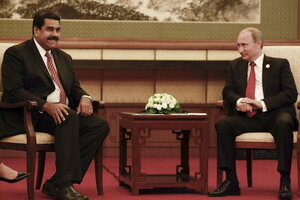Why Russia keeps pumping crude even as oil prices plummet
Russia – despite serious economic headwinds, and Western energy sanctions – is scrambling make sure it retains its status as a global leader in oil and gas.

Venezuela's President Nicolas Maduro (L) and Russia's President Vladimir Putin meet in Beijing, China on September 3, 2015. Russia and Venezuela did not reach agreement on measures to support global oil prices, Russian Energy Minister Alexander Novak told reporters on Friday. Russia and Venezuela need to combine efforts to lift oil prices, Putin told Maduro on Thursday, but refused to spell out any specific action, including output cuts.
Miraflores Palace/Handout via Reuters
The persistent collapse of oil prices has been chalked up to a game of chicken between US shale producers and the Saudi-led Organization of the Petroleum Exporting Countries. But there’s a third major producer whose response to sub-$50 oil has been to keep pumping more crude.
Russia – despite serious economic headwinds, and Western energy sanctions – is scrambling make sure it retains its status as a global leader in oil and gas.
As oil prices fall , the typical response from oil producing nations is to cut production in an effort to boost prices. But as prices tumbled – first last year, and now again this fall – , Saudi Arabia and the United States, two of the world’s largest oil producing nations, have continued to pump oil in a bid to maintain market share. Russian companies, meanwhile, are also ramping up oil output even as sliding oil prices cause its largely energy-based economy to nosedive. Russia is now pumping more oil than at any time since the fall of the Soviet Union, around 10.7 million barrels a day, according to Reuters.
The effects of low oil prices, both positive and adverse, have reverberated across the globe over the past year, impacting countries as far flung as Venezuela and Malaysia. As prices fall, countries whose main source of revenue comes from oil, such as Venezuela, are forced to increase outputs just to maintain their normal level of income, experts point out.
The same goes for Russia, but it may not be the only reason the country’s state-owned oil companies refuse to cut oil output. Unlike the Saudis, Russian authorities and businessmen aren’t as concerned with the price of oil, experts say. Instead, they’re using currency devaluation and other maneuvers to adapt to the low prices and continue business as usual. Meanwhile, Moscow is betting that new investments from the East will allow for a long-term increase in production.
“They have no sense that they are creating the problem,” says Chris Weafer, a founding partner of Micro-Advisory Ltd., a consultancy service for investors and companies looking to do business in Russia. “They see market prices as out of their control and they’ll deal with it. It’s a philosophy.”
For Russia, the real focus is on how to maximize cash flows and minimize the impact of the Western-led sanctions levied against Moscow due to its involvement in the conflict in Ukraine, experts say. As a result, Russia has been making moves to diversify its market away from Europe and court new partners in China and India.
“If China or anyone else is willing to give them money for oil, they’ll increase production,” Mr. Weafer says in a telephone interview. “The sanctions allow China and India to get better deals, but it’s still good business for Russia.”
China, among the world’s top oil importers, has signed a set of oil-for-loan deals with Russia in recent months. In May, Russia became China’s largest supplier of crude oil for the first time on record.
Meanwhile, currency devaluation has helped the government stave off some of the disastrous effects of low oil prices. Last year Russia abandoned its longstanding policy of defending a strong currency and floated the ruble. Since then, the ruble has devalued as the price of oil fell. Every extra barrel sold produces the same revenue in rubles, Weafer notes, allowing the government to keep its deficit in check.
Nevertheless, Western sanctions and low oil prices are producing a dearth of investment that could impact the future of Russia’s energy sector. In early September, Russian Deputy Prime Minister Arkady Dvorkovich conceded that reduced investment could eventually lead to a decline in output.
Ariel Cohen, Senior Fellow at the Atlantic Council’s Global Energy Center, also says that Russia’s flailing economy, compounded by old wells and outdated technology, could eventually force Russia’s hand and lead to output cuts.
“If they cut back it’s not because they want to; It’s because they don’t have the money, and they may not have the technology. In western Siberia these are old, exhausted fields. So they need to go deeper or develop shale, which they don’t have the money to do,” Mr. Cohen says. “This is the most serious crisis in post-communist Russia.”
Nevertheless, most experts agree that even if Russia does cut output, it won’t be by very much. Many of Russia’s oil producers are publicly listed companies beholden to the whims of minority shareholders. That means the government could potentially face legal challenges if it were to cut production significantly.
Moreover, Putin and his cronies have a vested interest in maintaining Russia’s dominance as a major global player, observers say.
“Putin has consistently said that Russia should maintain average outputs at 10 million barrels a day regardless of price. It gives you a steady stream of cash flow and it means you are an important participant in the global market,” Weafer says.

